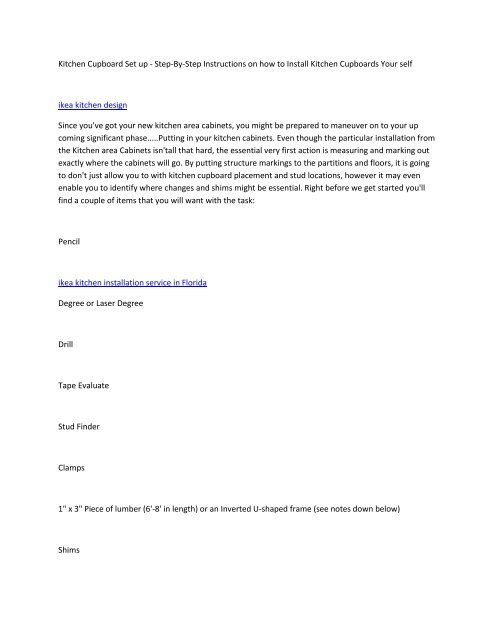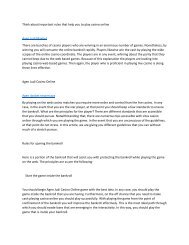You also want an ePaper? Increase the reach of your titles
YUMPU automatically turns print PDFs into web optimized ePapers that Google loves.
<strong>Kitchen</strong> <strong>Cupboard</strong> <strong>Set</strong> up - Step-By-Step Instructions on how to Install <strong>Kitchen</strong> <strong>Cupboard</strong>s Your self<br />
ikea kitchen design<br />
Since you've got your new kitchen area cabinets, you might be prepared to maneuver on to your up<br />
coming significant phase.....Putting in your kitchen cabinets. Even though the particular installation from<br />
the <strong>Kitchen</strong> area Cabinets isn'tall that hard, the essential very first action is measuring and marking out<br />
exactly where the cabinets will go. By putting structure markings to the partitions and floors, it is going<br />
to don't just allow you to with kitchen cupboard placement and stud locations, however it may even<br />
enable you to identify where changes and shims might be essential. Right before we get started you'll<br />
find a couple of items that you will want with the task:<br />
Pencil<br />
ikea kitchen installation service in Florida<br />
Degree or Laser Degree<br />
Drill<br />
Tape Evaluate<br />
Stud Finder<br />
Clamps<br />
1" x 3" Piece of lumber (6'-8' in length) or an Inverted U-shaped frame (see notes down below)<br />
Shims
Screws (extensive plenty of to go 1 1/2 in to the studs)<br />
Utility knife or chisel<br />
Marking Compass<br />
An additional established of palms (you could possibly have to bribe one of the mates)<br />
As I discussed over, you've got the choice of employing a bit of 1' x 3' lumber for the installation or<br />
building a frame to guidance the cabinets (I have incorporated an image of the sample frame beneath).<br />
This can be made from 2' x 4's and should be tall ample to help the bottom of your wall cabinets. If you<br />
prepare on putting in multiple kitchen, then I'd personally counsel the body, but a piece of lumber will<br />
do just great if this can be a one time celebration. In either scenario, you might have to have a further<br />
established of fingers to aid with the installation.<br />
In this instance we acquired (RTA) Ready-To-Assemble <strong>Kitchen</strong> area <strong>Cupboard</strong>s from RTA <strong>Kitchen</strong> area &<br />
Bathroom <strong>Cupboard</strong> Store. Now the kitchen area cabinets are assembled, we are completely ready to<br />
start marking out our format lines. Some people start with all the base cabinets, but we are going to<br />
start while using the wall cupboards initially. There is no right or wrong way to start, I just prefer to start<br />
while using the upper cabinets first.<br />
1. Use a stage and a pencil to draw a parallel line across the wall about three inches up from the floor.<br />
Evaluate down from this line, towards the floor, and find the flooring high point (if it has one particular),<br />
and mark a line at that point. From that high point, Evaluate up 34 1/2 inches and draw a amount line<br />
across the wall to designate the top on the base cabinets.<br />
2. Now that you might have the top on the base cabinets marked, measure up yet another 19 1/2 inches<br />
and a level line across the wall to indicate the bottom from the wall cabinets. Lightly mark each cabinets'<br />
dimensions and placement around the wall to make sure that your original format is correct.
three. Use a stud finder to track down the wall studs. Use a pencil to mark the stud locations at least 6<br />
inches earlier mentioned and underneath the line with the bottom of the wall cupboards. Draw straight<br />
vertical lines between the top and bottom marks to indicate the center from the studs.<br />
4. In the event you decided to go using the piece of 1' x 3' lumber, now is the place you will use (if you<br />
decided to go with the U-shaped frame, it's going to come into play after all your lines are laid out).<br />
Screw a temporary 1' x 3' aid rail on the wall, aligning the top edge in the rail while using the line with<br />
the base edge on the wall cabinets. Attach it by driving three or 4 two inch screws through the rail into<br />
the wall studs.<br />
5. Given that we have all the lines marked, it is time to start setting up your kitchen cabinets. We are<br />
going to start with all the corner cupboard (here is the place your helper's excess established of hands<br />
will likely be needed). Place the corner cabinet onto the temporary assist rail and have your helper hold<br />
the corner cupboard in place. Drill pilot holes through the sturdy cabinet back or its assistance rail and<br />
into the wall studs. Screw the cupboard in the wall using two screws that are long enough to penetrate<br />
the studs by at least 1 1/2 inches. Check the top of your cupboard for amount and the front from the<br />
cabinet for plumb. When you have to correct the position, just back the screws out a little bit and top<br />
shims behind the cabinet at the stud spots. If it is plumb and degree, drive the screws all the way in and<br />
add several much more into each stud to ensure that the cabinet is secured tightly towards the wall.<br />
6. Now we are going to maneuver onto the cabinets on possibly side of the corner cabinet. As you install<br />
each 1, use the clamps to secure each cabinet to the neighboring cupboard and then check it for plumb<br />
with your amount. On faceframe cupboards, it is actually a good idea to drill two 1/8 inch pilot holes<br />
through the sides on the faceframe and use screws. In cases like this, with frameless, ready-to-assemble<br />
kitchen area cupboards we are going to screw through the plywood sides and use shims in between the<br />
cupboards to ensure a tight fit and make sure that the cabinet faces are plumb.<br />
7. After all the wall cupboards are in place, put in the corner or end base scenario cabinet. Use shims the<br />
place needed to degree the cabinet and raise it up to the line which indicates the high point of your floor.<br />
Be sure it is stage from front to back and from side to side, then screw it to your wall studs. When you<br />
don't have a diagonal corner cabinet or blind base cabinet in the corner, push the adjoining cabinet into<br />
place and clamp the two units together. Add a filler strip if needed to allow the doors and drawers<br />
adequate clearance to open and close properly. If necessary, tap shims under the cupboard and behind<br />
it to adjust for plumb and level.
8. Drive screws through the cupboard back (and shims) in the wall studs. Trim any excess material from<br />
the shims with a sharp chisel or knife. Continue to add adjoining cupboards during this manner, joining<br />
them the same way you connected the wall cabinets in move 6.<br />
9. If your cupboards end up butting against a further wall, chances are you'll will need a filler strip to<br />
make up the last few inches. In the event you have custom cupboards, they should really have been built<br />
to fill this gap, but for those who are working with stock or RTA <strong>Kitchen</strong> <strong>Cupboard</strong>s the filler strip could<br />
be needed. Should you do have to have to use a filler strip, leave the last cabinet detached from the<br />
other cupboards. Clamp a straightedge to the face of the nearest installed unit, extending far adequate<br />
for you to put alignment marks within the end wall. Allow a 3/4" offset behind those marks (for your<br />
thickness of the filler piece) and fasten a cleat on the wall. Then install and fasten the last cabinet and<br />
measure the gap between its face body and the wall.<br />
If the wall is flat, simply rip the filler board for the required width and fasten it in place. If the wall is<br />
irregular, you'll really have to scribe-fit the filler board. Start by setting a marking compass to the width<br />
of your gap, then place a strip of 1"-wide masking tape along the filler board in the area wherever it<br />
needs to be trimmed. Clamp the board on the end cabinet's face frame, then trace the wall contour<br />
together with the compass. Remove the board and cut along the scribe line with a jig saw, then reinstall<br />
it to check the fit. When it's right, drive screws through the adjacent face body to the edge of your filler<br />
board. Screw or nail the other side towards the cleat.<br />
At this point, your kitchen area cupboard set up is complete. If you purchased matching crown molding<br />
or any other details, these really should be easily installed now. Depending on whether you had to use<br />
shims under the base cupboards, it's possible you'll really have to put in some trim pieces by the toe<br />
kicks to cover up the shims or any gaps at the underside with the kitchen area cabinets.<br />
I hope this helps make your kitchen area cupboard set up as smooth as possible. In the event you need<br />
to have any assist with cupboard selection, kitchen area format tips, or ideas for cupboard styles, check<br />
out RTA <strong>Kitchen</strong> area & Bathroom Cabinet Store.

















